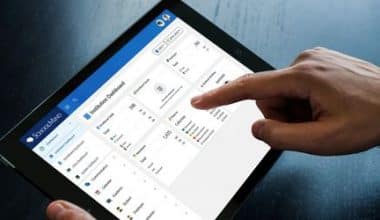Hey, what’s the use of valuable products or services without sales? And how can you possibly increase sales without a robust distribution management system? In recent times, the supply chain has been more effective. Businesses avoid stockouts and overstocking, and firms can get real-time data from distributors thanks to modern DMSs. The right distribution management system can support sales and distribution operations even in a fragmented market. They also streamline all activities and procedures that relate to distribution. In fact, every business that wants to integrate an advanced distribution management system with either open-source or premium applications will definitely increase its revenue over time.
What is Distribution Management System?
Distribution management is the process of controlling how products move from a supplier to a manufacturer, down to the wholesaler or retailer, and finally to the final consumer. A few of the processes and activities involved are the management of raw goods vendors, packaging, warehousing, inventory, supply chain, and occasionally even blockchain.
Planning each step required to deliver goods to customers on time and with the least amount of waste is at the heart of distribution management. It consequently has a direct impact on profitability.
Distribution management is a crucial part of the business cycle for distributors as well as wholesalers. Generally, an organization’s profit margins are the results of its product turnover. The faster, the better. As they sell more and generate more revenue, the company’s future will become more promising. A strong distribution management system is essential for businesses to keep their competitiveness and customer satisfaction levels high.
Benefits of Distribution Management
In addition to increasing profitability, distribution management also decreases waste in a number of ways. This includes less spoilage to lower warehousing costs. In all, products can be dispatched as needed (“just in time” inventory) as opposed to being kept in larger quantities(“just in case” inventory).
Moreover, one-stop shopping and other perks, such as customer loyalty reward programs, are made possible by distribution management. This also lowers shipping costs and speeds up delivery to customers. Additionally, it simplifies things for customers.
Three Techniques for Distribution Management
At the strategic level, there are three distribution management strategies:
#1. Mass.
The target market for the mass strategy is the mass market, which includes companies that sell to a wide range of clients everywhere.
#2. Selective.
The selective distribution approach aims to target just specific manufacturers or retail sectors, like pharmacies, hair salons, and upmarket department stores.
#3. Exclusive.
The exclusive distribution strategy’s target market is a very niche one. For instance, makers of Gucci-brand goods only market to a select group of upscale retailers, and those of Ford cars only market to authorized Ford dealerships.
Best Distribution Management System
Distribution management systems help businesses keep tabs on their distributing channels. While this may be offer to businesses, i’s difficult trying to the exact distribution management system from diverse applications. Not to worry, we’ve taken care of that. So, check out our list of best distribution management system applications.
#1. InsureCRM
Brokers, customers, and insurers all have specific needs that are catered to by the agile CRM software for the insurance industry known as InsureCRM. It is an excellent tool for maintaining customer-centricity. Make an appointment for a free consultation to determine whether you could benefit from it.
#2. TallyPrime
TallyPrime, one of the best business management tools now in the market today, is well known for its accounting, stock management, reporting, and payroll features. For small and medium-sized organizations, TallyPrime is cost-effective because you don’t have to pay extra for supplemental functionality. 2 million businesses worldwide use it.
#3. Horizon ERP
Simple billing software with complete inventory and account features. It is reliable, quick, and easy to maintain. It’s ideal for businesses that handle hundreds of SKUs and issue numerous invoices. It is often used by merchants, distributors, and small manufacturers.
#4. LOGIC ERP
With Logic Enterprise, a fully integrated ERP solution, organizational activities in the manufacturing, distribution, and retailing sectors are simplified. LOGIC ERP is one of the most advanced and cost-effective ERP systems on the market.
#5. DeltaSalesApp
The Delta Sales App is a Field Sales Automation & Employee Tracking App for Distributors, Manufacturers, Wholesalers, and Companies with Field Employees. It helps companies increase customer interaction, boost field force productivity, and cut back on administrative work, all of which lead to higher revenue. Order reporting, customer management, employee tracking, attendance, beat planning, and many other features are among the features.
#6. PharmAssist
A full solution is provided by the medical distribution software application PharmAssist, which has the quickest billing and the most organized, scientifically-based stock arrangement. This expedites stock removal and delivery.
#7. Astral Inventory Management System
The Astral Inventory Management System manages several location branches from a single location and was developed with the most up-to-date technology for flexible working. It is compatible with tablets, smartphones, desktop computers, and laptops. It provides complete control over the acquisition, storage, and sale of items and provides real-time status updates.
Open Source Distribution Management System
By keeping track of physical goods, suppliers, customers, and all the myriad moving parts associated with each, specialized software can significantly help in managing these workflows. It might even be absolutely necessary in some cases. Let’s take a peak at some of the best open source distribution management system available for businesses. By the way, every open source distribution management system are generally free supply chain management software programs or applications, and some of their features.
#1. Openboxes
The first open source distribution management system on our list is Openboxes. Experts in the sector specifically built this supply chain management program. It is open source and free. Openboxes is software made for organizations with a limited amount of physical and digital infrastructure or low-resource situations. Thanks to its fully customizable user interface and straightforward methods, this SCM software aids businesses in planning inventory management and forecasting more correctly when faced with uncertain business conditions.
Three languages are available for customer service, and the Openboxes community members are constantly innovating the system to address healthcare supply chains. The on-site solution’s basic version of the software is free, but more advanced versions are not.
#2. O2b Technologies
The existence of an open source supply chain software solution enables companies to leverage their platform to maintain a seamless operational network. A highly integrated piece of software called the O2b system has the potential to streamline the entire supply chain process. The creator of the supply chain management software system promises sustainable profitability and production effectiveness. The supply chain management software system promises to enhance both sophisticated shipping techniques and fundamental operational insight across the whole supply chain.
#3. GMDH Streamline
Thanks to this free supply chain software, manufacturers and retailers are currently managing $3 billion in inventory. The company claims to help customers estimate and plan purchases up to twice as rapidly while lowering the risk of stockouts and excess inventory. The free supply chain management software is acclaimed for its smooth user interface and superb software integration possibilities. Additionally, it offers premium versions with a wealth of features for quote-based prices.
#4. Odoo Inventory
Simple connections to a wide range of apps are made possible by the open-source supply chain management software from the Odoo stable. Odoo is used by more than 5,000,000 individuals, and they have made this service as complete as the rest of their catalog. The core of the supply chain management tool is double-entry inventory systems, which boost efficiency and protect just-in-time inventories. Additionally, it automates a variety of tasks and ships products using an algorithm called “advanced routes.”
#5. MargERP
With the aid of the supply chain management tool Marg ERP, buyers are ensured outstanding benefits in terms of order fulfillment, scheduling, and supply chain optimization. The company, which has its headquarters in India, asserts that it helps more than 850 different kinds of businesses and manages over $100 billion in transactions annually. The supply chain software’s cooperation features and ease of modification ensure that the business complies with tax laws. The SCM system software also gives business users a competitive edge thanks to its versatile and extensive range of sophisticated capabilities.
Advanced Distribution Management System
An advanced distribution management system is the software framework that supports the full spectrum of distribution administration and optimization (ADMS). An ADMS has capabilities that automate outage restoration and improve the effectiveness of the distribution grid. Some of the ADMS services being developed for electric utilities include fault location, isolation, and restoration, volt/volt-ampere reactive optimization, voltage reduction for energy savings, peak demand management, and support for microgrids and electric vehicles. Get the most advanced distribution management systems for your business.
#1. Spectrum Power ADMS
Top on our list of advanced distribution management system is Spectrum Power ADMS. The Spectrum Power Advanced Distribution Management system (ADMS) from Siemens makes it possible to restore service more quickly than previously. Advanced network and fault analysis, distribution SCADA, and outage management are all combined in one application. Everything is accessible through a common user environment to optimize advantages for the operation of tomorrow’s grid today. The grid system has become increasingly complex, but Spectrum Power ADMS makes managing it easy.
#2. EcoStruxure
In order to guarantee power dependability and reduce energy-related capital and operational costs, Schneider Electric (formerly Invensys Software) offers EcoStruxure Power Monitoring Expert Building Edition, an energy management solution. EcoStruxure’s power management is tailored to your buildings. Consider EcoStruxure for businesses looking for a reliable solution to electrical preventative maintenance breakdown prevention. System for managing energy.
An energy management system called ETAP was developed to reduce energy use, improve system performance, forecast how well your electrical systems will function, and optimize energy use to help cut expenses. With the help of ETAP, the electrical power systems at your firm may be studied, simulated, controlled, optimized, and automated.
#3. SurvalentONE ADMS Platform
The SurvalentONE advanced management system (ADMS) platform combines a user-friendly graphical user interface with an outage management system (OMS), distribution management system (DMS), and supervisory control and data acquisition (SCADA) solution. Because of its safe Windows platform, SurvalentONE successfully combines, sorts, and processes data from various sources.
#4. Surple
The last advanced distribution management system on our list is actually Surpe. Surple, is a cloud-based energy management solution that assists businesses in making better-informed energy decisions. It’s compatible with all utility data types and uses machine learning to detect sudden spikes in energy use.
What Does a Distribution Management System Do?
Distribution management oversees a company’s whole supply chain, including packaging, inventory, warehousing, and logistics, from manufacturers to retailers to vendors and suppliers.
What is Distribution Management DMS application?
The use of a computer system and software to store, manage, and track electronic documents and electronic images of paper-based information obtained through the use of a document scanner is known as document management, also referred to as document management systems (DMS).
What Is The Difference Between OMS and DMS?
The main purpose of the outage management system (OMS) applications is outage response. The combined DMS/OMS model’s electrical data, including information on line and cable impedances, equipment ratings, and customer load characteristics, is used by the distribution management system (DMS) applications to operate networks electrically.
What is DMS Automation?
DMS Automations offers machine-specific analysis and design concepts in addition to assistance with the selection, design, and commissioning of suitable products.
What Are the 4 Steps in the Distribution Process?
Producer, customer, wholesaler, and retailer. These are the standard stage of product distribution, where a product passes from producer to wholesaler to distributor to retailer to customer.
What Are The Advantages of Distribution Management?
Distribution management facilitates “one-stop shopping” and other conveniences and rewards, such as customer loyalty rewards programs, and reduces shipping costs and speeds up delivery to customers. It also makes things easier for purchasers.
How do you create a distribution strategy?
- Evaluate the end-user
- Look for possible marketing middlemen
- Research potential marketing intermediaries
- Find the most profitable ways to sell your product
- Keep tabs on your channels of distribution.
Conclusion
In the business environment, it isn’t enough to have great products or services. Sales is also a checklist that must be met to improve revenue. And to keep up with sales, every business must build a solid distribution management system. I mean, what good is a product when it records little or no sales? It’ll be a complete waste of time and resources. Trust me, you don’t want to experience that. So, take advantage of the various distribution management system open source applications available and keep tabs on the entire distribution process.
Distribution Management System FAQs
What are the 3 distribution strategies?
- Intensive Distribution
- Exclusive Distribution
- Selective Distribution
What is direct distribution?
In simple terms, direct distribution is a “direct-to-consumer” method in which the manufacturer is in charge of every part of the distribution process.
- DOCUMENT MANAGEMENT TOOLS: Uses, Free Tools & Guide
- DOCUMENT MANAGEMENT SYSTEM: Definition & 15 Best Software Solutions
- MARKETING CHANNELS: Top 10 Digital Marketing Channels
- What is Supply Chain Planning? Detailed Guide






